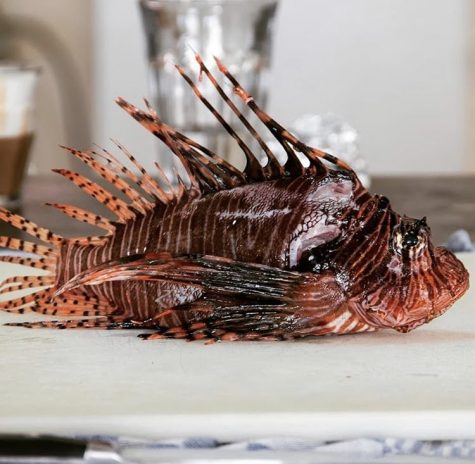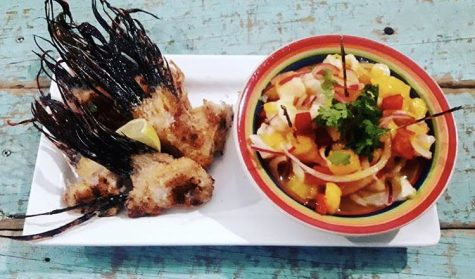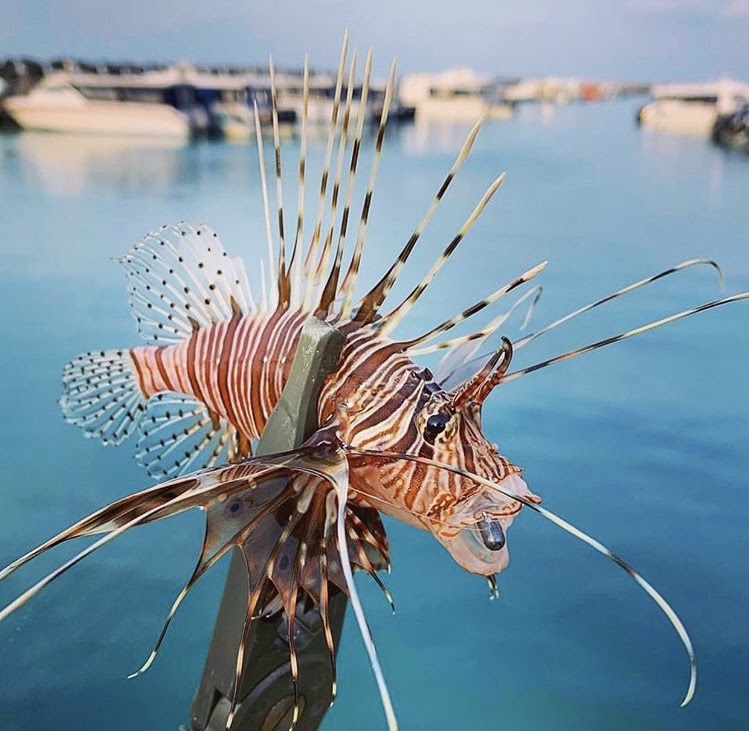Savage Predators On Our Dinner Plates
Consuming lionfish may be the key to stopping this notoriously invasive species.
The poisonous spikes of the red lionfish induce pain and sweating and, in extreme cases, respiratory problems and paralysis, but baking the spines render them harmless.
Spanning from shades of dark brown to crimson red, its impaling spines shooting out from every inch of its striped body, the lionfish is the perfect predator. The red lionfish (Pterois volitan) and the devil firefish (Pterois miles ) are two species of lionfish that have become extremely invasive over the past four centuries.
Native to the Indo-Pacific Oceans, they have attracted attention as colorful, funny-looking, aquarium pets. The earliest sightings of lionfish in their non-native habitats was all the way back in the 1980s, but it wasn’t until 2001 that the populations started moving up the East Coast of the United States, wreaking havoc on native species and destroying reefs in the Atlantic, Gulf of Mexico, and the Caribbean.
Experts speculate that lionfish pet owners dumped them into the ocean after the fish ate all of their other expensive tank-mates. In general, lionfish are very hard to maintain. They consume a variety of 70 underwater organisms, some of which are keystone species in their ecosystem like the parrotfish, whose role is cleaning algae off of corals. Lionfish can expand their stomachs to accommodate meals 30 times their body weight. Measuring fifteen inches and weighing 2.5 pounds, that is an average of 75 pounds of food per day.
After a year, most females reach sexual maturity and release two million eggs annually. With no natural predators and the ability to survive in all marine conditions, the population growth goes unchecked. Lionfish have increased appetites in warmer waters as compared to colder ones, but this is bad news for the native species because climate change is on the rise equating to higher temperatures.

Lionfish usually snack in one area until the species they eat goes extinct, decreasing biodiversity and destabilizing the coral reefs. Studies show that one lionfish can wipe out 79% of juvenile fish in a span of five weeks and can decrease biodiversity by as much as 10%. If the issue is not properly addressed, our oceans will be overrun by algae without the parrotfish, which block underwater plants from receiving sunlight. Once these plants die, the amount of dissolved oxygen in the water falls dramatically and this ripples over to other species, increasing the death count and leaving nothing but an ocean of sediments and decomposers. What could possibly lead to their demise?
They taste delicious.
Many organizations and sea lovers are already looking for ways to save the reefs, and one solution among these has been gaining momentum, resting in the hands of chefs and home cooks. Organizations like the National Oceanic and Atmospheric Administration (N.O.A.A.) have paired with other nonprofit organizations like the Reef Environmental Education Foundation (R.E.E.F.) to host derbies where divers compete for the largest, smallest, or the most lionfish caught. Some of the catches are passed along to professional chefs who cook the fish for fundraising, while the rest are taken to other restaurants or supermarkets. Divers who attend are able to have fun, while also helping to save the local ecosystem. Every derby takes an average of 1,100 lionfish out of the ocean, and while this number may seem small, there is a significant decrease in the population after every event.

Although the organizations dedicated to keeping the population under control are extremely helpful, most of the change comes from committed individuals. Earlier this month, I had the opportunity to interview the lionfish huntress, Lisette Keus, a woman who has devoted herself to saving our marine ecosystems .
Keus grew up in the Netherlands, Australia, and Curacao. As a kid, she loved diving, animals, and adventure. She worked as a journalist for a few years before returning to Curacao for work in 2010. “I went for a dive and saw a lionfish. I never saw it here and was very surprised,” Keus said, “So I did an interview with a marine biology research center about lionfish. I found out we needed to control the population, so I started hunting.”
Since then, she quit her job and has dedicated her life to hunting and selling lionfish. Her days are split between diving, making sustainable jewelry, holding instructional classes, and organizing larger events like Catch & Cook. Like most environmentalists, she felt wasteful by leaving the lionfish underwater after she killed them, so she walked into restaurants with buckets full of fish in order to teach chefs how to clean them, and she has introduced numerous recipes.
“Slowly restaurants picked it up and they started to have the lionfish on their menus. Now 10 years later, we have more orders than we can fulfill! People are eating it, and that is the most important thing — still being able to eat fish, but leaving the snapper and choosing the lionfish instead!”

Of course, Keus is not the only person battling this invasive species. Lionfish recipes are on the rise, and there are plenty of restaurants encouraging their customers to try it. The stigma surrounding this outlandish menu choice is slowly decreasing, and people are realizing that the species really tastes good. There is even a Lionfish Patrol app being developed in order to help divers locate lionfish-heavy parts of the ocean. There are numerous methods being used to keep the lionfish population in check, because, after all, who is better equipped to fix the problem than the most invasive species of all, humans?

“Slowly restaurants picked it up and they started to have the lionfish on their menus. Now 10 years later, we have more orders than we can fulfill! People are eating it, and that is the most important thing — still being able to eat fish, but leaving the snapper and choosing the lionfish instead!” said Lisette Keus.
Nicole Zhou is the Editor-in-Chief for ‘The Observatory' yearbook and a Staff Reporter for 'The Science Survey' newspaper. This is her third year revising...

